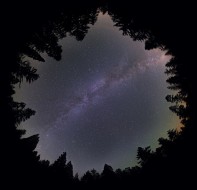Hidden Galaxies Revealed
Astronomers studying the infrared glow that pervades the universe have pinned down its source: dusty, faint, and faraway galaxies.

Chad Quandt / Online Photo Gallery
If you’re ever fortunate enough to see the Milky Way in a dark sky, take a moment to gaze at that dim glow that emanates from our galaxy’s billions of stars. They’re much too faint and faraway for our eyes to make them out so they blend into a fuzzy patch of light. It takes powerful telescopes to separate out the stellar Tom, Dick and Harrys in the galactic center, for example.
A similar challenge presents itself in the infrared sky. Astronomers have long puzzled over a faint thermal glow that pervades the universe, the so-called cosmic infrared background. Until recently, though, telescopes have lacked the sensitivity to find its source.
Enter ALMA. The Atacama Large Millimeter/submillimeter Array consists of 66 radio dishes working together high in the Chilean desert, collecting submillimeter-wavelength radiation with unprecedented sensitivity. So when Seiji Fujimoto (University of Tokyo, Japan) and colleagues pored through ALMA observations, they saw not a vague background glow but more than a hundred tiny, dusty galaxies. The astronomers have published their results in the Astrophysical Journal Supplement.
The Glow of Hidden Galaxies
Artist’s impression of the Cosmic Infrared Background resolved with ALMA.
NAOJ
NAOJ
In addition to their own data, Fujimoto’s team pulled together all the public data they could find, excluding only those fields with very bright sources such as quasars. In each field, they picked out and tallied up faint millimeter-wave sources that were lurking in the background. In the end, they found 133 sources, including one object that’s five times fainter than any other ever detected at this wavelength.
The astronomers found that these incredibly faint sources accounted for all of the cosmic infrared background. “This is something I was dreaming of seeing about 15 years ago!” says Herve Dole (University of Paris South, France), who was not involved in the current study.
But what are they?
Looking to other wavelengths, Fujimoto’s team found matches in the visible and near-infrared for just over half of the sources (59%). These are probably star-forming galaxies living in a universe at the peak of its stellar baby boom. Dust absorbs starlight and re-emits it at infrared wavelengths. By the time that light reaches us, the expanding universe has stretched it to millimeter wavelengths.

Breakdown chart of the faint objects detected with ALMA. 59% of them have corresponding optical/infrared galaxies, whereas the remaining 41% have no matches at any other wavelengths.
ALMA (ESO / NAOJ / NRAO), NAOJ / Fujimoto & others
ALMA (ESO / NAOJ / NRAO), NAOJ / Fujimoto & others
And the other half? These more mysterious sources have no counterparts at other wavelengths. But “this is paradoxically less surprising to me,” Dole says. He guesses these sources are galaxies so enshrouded in dust that even infrared light can’t get out. Though surveys covering optical and near-infrared wavelengths often miss such galaxies, searches at other wavelengths have proven more fruitful.
Indeed, ALMA is just the latest player in the game to detect more of the universe’s hidden galaxies, but finding them is just the first step. Future studies, with ALMA as well as other telescopes exploring beyond the visible regime, will help us understand these galaxies’ role in galaxy formation and evolution.
No comments:
Post a Comment